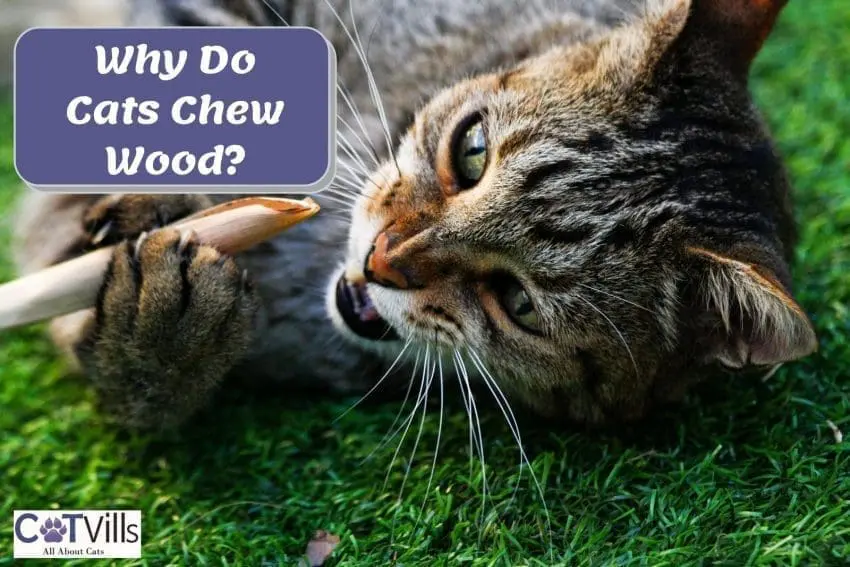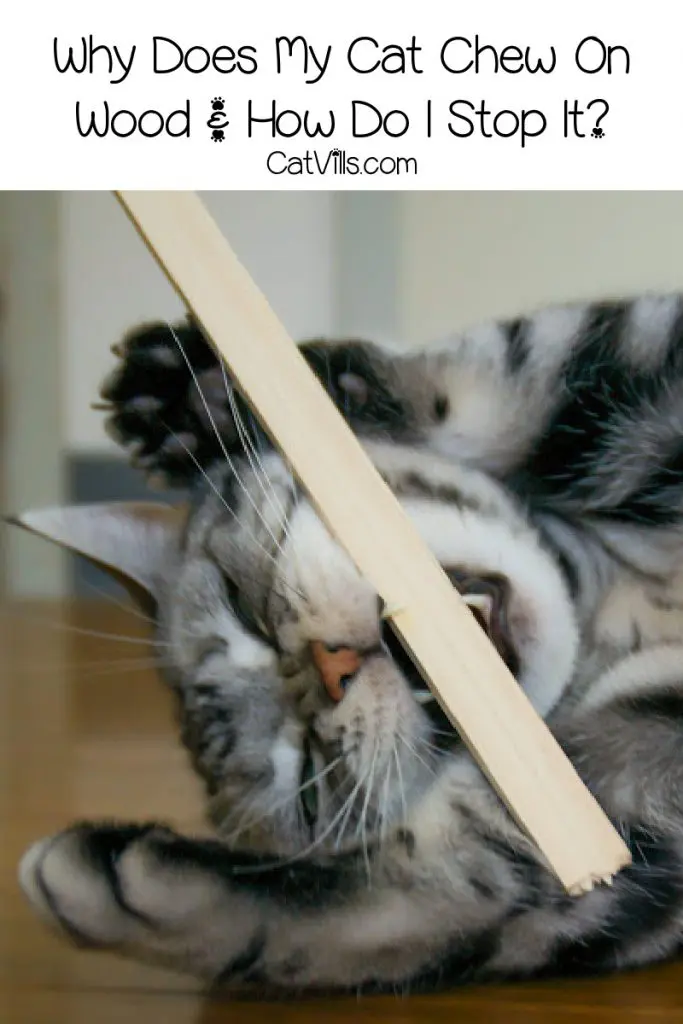Last Updated: 4 months ago
Why does my cat chew on wood? More importantly, how can I prevent it in the future?
If these questions are at the top of your mind, keep reading.
Below, we’ll talk all about this strange cat behavior, what it means, and how to stop it.
Why Does My Cat Chew on Wood?

Is your cat chewing on wood furniture, wood art, cardboard boxes, and other wooden items?
Cats do a lot of strange things out of curiosity. But once they start chewing on wood and other inedible objects, don’t shrug it off.
They could be suffering from a medical condition, and the chewing will only make it worse.
What medical condition causes cats to chew on wood?
Chances are, he or she could be suffering from pica.
Pica is a condition that makes cats chew on non-food items such as wool, metal, wood, and even electric cords.
Pica is often associated with medical issues such as obsessive-compulsive disorder, dental issues, or a mineral deficiency in their meals.
Let’s look at the condition in a bit more detail, and then we’ll talk about prevention tips.
What is PICA? (+ 5 Potential Causes)
As stated above, PICA is a condition where cats crave items with no nutritional value.
Below are some of the main causes of PICA in cats.
1. Genetics
PICA is believed to be a genetic condition for some cats.
That’s why the Birman and the Siamese cats seem to be more affected than other cat breeds.
Crossbreeding with these cat breeds transfers these traits to other cat breeds.
2. Dental disease
Cats suffering from dental issues such as tooth resorption, periodontitis, or gum disease may develop a chewing habit to ease the pain and discomfort.
Maintaining good dental health with feline toothbrushes and cat-friendly toothpaste can go a long way toward preventing these diseases.
3. Compulsive disorder
This disorder causes cats to engage in repetitive behaviors that don’t serve any purpose.
A chewing obsession is one of them. Others include over-grooming, tail-chasing, or twitchy skin syndrome.
4. Behavioral disorder
A bored cat may develop a furniture obsession.
And cats can get bored for several reasons, including being left by their owner, being introduced to a new environment, a lack of physical exercise, or even depression.
If your cat has a behavioral disorder, a qualified cat behaviorist can suggest behavior modification recommendations to help the cat quit the furniture obsession.
5. Mineral deficiency
Cats should get all the necessary nutrients, or most of them, from their meals.
If their food lacks a particular nutrient or mineral, they’ll try to find it in other non-food objects.
Ensure the cat food you’re feeding him/her has all the nutrients according to his/her lifestyle.
For instance, a cat with lots of energy will need more iron compared to a sedentary cat.
If they can’t get all the nutrients from the food, consider feeding them supplements, like Missing Link.
Other Medical conditions
If your cat is suffering from the Feline Immunodeficiency Virus (FIV), diabetes, or feline leukemia, he or she may develop a chewing habit.
It’s advisable to take your cat to the vet to rule out any of these medical conditions.
PICA Challenges
As you can imagine, eating nonedible objects can cause some major problems for your cat.
Let’s look at some specifics of his wood-eating habit.
Splinters
When the small pieces of wood get stuck in a cat’s paw, they could cause splinters.
These are not just painful; they can also become infected if not treated as soon as possible.
Life-threatening Intestinal Obstructions
But when ingested, the wood can cause life-threatening intestinal obstructions.
These could result in tissue death or death of some parts of the intestine wall.
Some symptoms of this obstruction include;
- Vomiting
- Low body temperature
- Lethargy
- Diarrhea.
- A lack of appetite
- Abdominal pain
Furniture is also treated with chemicals that could be harmful to your cat.
How Do I Get My Cat to Stop Chewing on Wood?
Below are some practical tips on treating your cat’s wood obsession.
#1 Introduce acceptable items for chewing
To keep your cat’s mind off of chewing on wood, introduce acceptable items or items that are safe for them.
These may include cat-safe chicken or turkey jerky. If they are suffering from any dental issues, introduce dental chew toys.
A good example is the Petstages dental health toy designed to minimize a kitten’s teething pain.
And it’s even sprayed with catnip to keep the kitty entertained. You can also spray catnip on other safe chewing toys.
But ensure the chewy toys don’t have any other spices.
#2 Environmental Enrichment for Cats
Creating an enriched environment for your cats includes allowing them to practice their usual natural habits, such as playing around, chewing, and scratching indoors.
You can do this by creating ample space for them to move around, adequate food and water, and ways for them to stay active.
For instance, you can create lots of shelves and place them in different areas of the house.
And then place some of the cat’s favorite items on these shelves. Tall cat trees are also excellent ways to keep the cat busy.
To give your cat something to do, introduce interactive toys such as tract toys or the YOFUN smart interactive toy.
It’s a simple ball with a red light that you place on the floor. And since cats love tracking moving objects, this toy will keep them busy for a while.
You can also purchase puzzle boxes and place the interactive toys in them. It would be best if you found toys the cat can’t chew.
#3 Consistent Schedule
Engage your cat in a consistent schedule of meals and playtime.
You can purchase timed feeding stations that will feed the cat based on how you’ve scheduled them.
Instead of large meals spaced out over several hours, try smaller meals after a few hours.
Play with your cat for a few minutes every day. You can play interactive games or just cuddle with them.
Cats on a schedule know what to look forward to and when, so they’re less inclined to stress-chew objects they shouldn’t.
#4 Clicker Training
Clicker training is often used to train dogs, but it still works for cats.
You use a handheld clicking device and click and offer a treat every time your cat does what she’s trained to do.
Your cat will associate not chewing on wood with a treat, and eventually, they’ll quit the habit.
#5 Spraying the Wooden Structures
Bitter apple spray is one of the safest and most effective ways to prevent your cat from chewing on wood.
It has a displeasing taste, which the cats don’t like. But it’s not always effective since some cats may develop a liking for the flavoring.
If that’s the case, try using hot sauce. It’s a little cruel for some people, but it works great at repelling cats.
Conclusion
Now you know why your cat chews on wood and what you can do to prevent it.
Please take my first bit of advice and make that call to your vet a top priority.
Only after you’ve ruled out other problems can you really focus on stopping this strange behavior.
Does your cat chew on wood? Have you tried any of these tips? Share your experiences below.
Resources:


Barry Stingmore is a British content creator living in Fuerteventura, Spain. An animal lover at heart, he shares his home with a dog and four rescue cats. Barry works with the island’s animal charities to help manage and care for feral and abandoned animals. Alongside fieldwork, he works to support the charities with fundraising and raising awareness.
